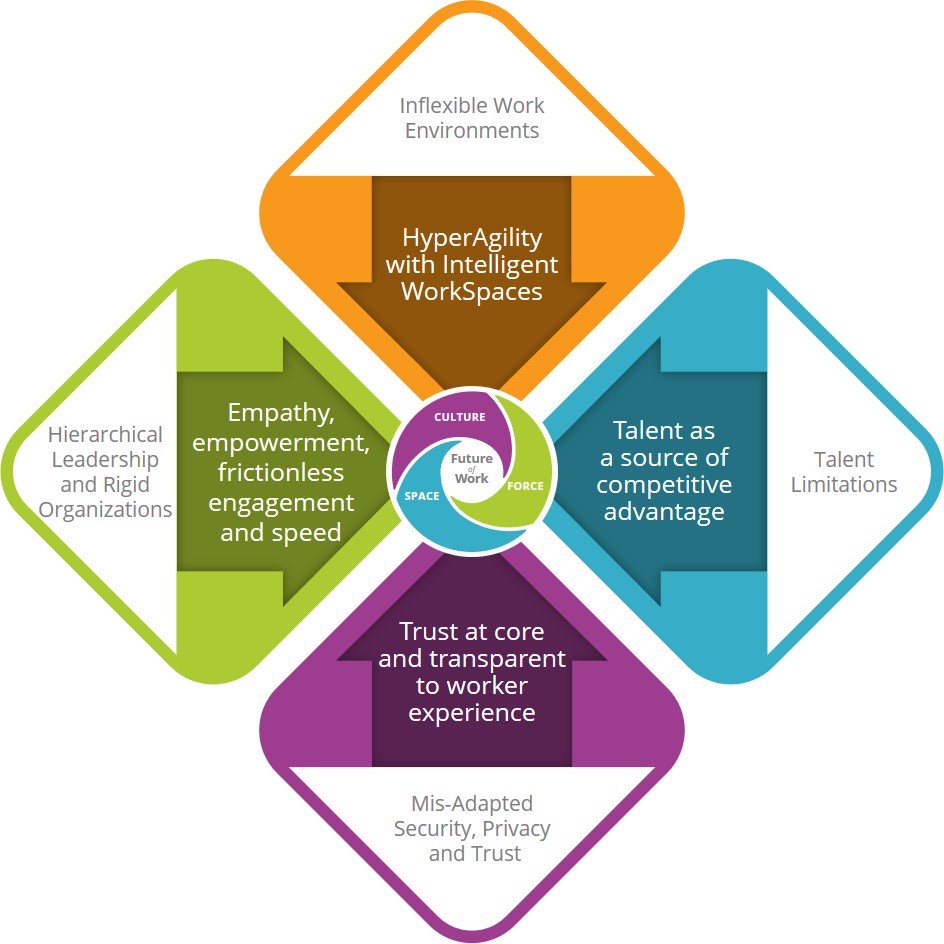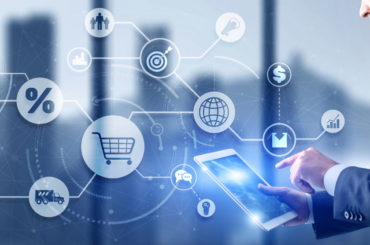For decades, technology advancements have changed the way we work, and organizations have adapted. In today’s fast-paced digital world, work transformation – the “future of work”- is a major disruptive force, and organizations are having a hard time keeping up.
Traditional work models aren’t nimble enough, adaptive, nor scalable. In the new work experience, human workers operate side by side with “digital coworkers,” enabling human workers to focus on higher-value activities. The future of work is about the rise of humanism as the new driver of value — with skills such as imagination, creativity, and empathy gaining prominence. This requires entirely new work environments, organizational structures, and metrics for success, not only incremental adjustments.

In a recent IDC Perspective, IDC has described four sets of challenges that organizations face related to work transformation, and a set of discrete goals that must be met to address those challenges, and digitally transform. The below challenges and goals can help you identify areas of improvement in your organization or shape your product or service positioning to align with your customer’s needs.
Work Transformation Challenges and Goals
Challenge #1. Inflexible Work Environments
Let’s face it. Work environments from 20 years ago are no longer agile enough for organizations to succeed over the next 20 years. Manual, repetitive operations limit scalability and growth. Monolithic, bloated, nonintegrated applications hinder effectiveness and demoralize workers. The sheer number of tools and data types required to complete a work process introduces excessive friction and context switching, further depressing speed and productivity and increasing worker disengagement. Challenges related to security and connectivity limit access to corporate resources, resulting in work activities that are bounded by physical structures and specific times of the day.
Goal: Establish an intelligent digital workspace.
IDC predicts that by 2024, one third of G2000 firms will rely on a global, secure, intelligent, highly integrated, and collaborative intelligent digital workspace that enables enterprises to function as borderless organizations. An agile and scalable work environment gives rise to a hyperscale, hyperspeed, and hyperconnected organization.
Challenge #2. Talent Limitations
As the pace of technology advancement accelerates, the “half-life” of relevant and required skill sets declines. In fact, 75% of respondents to IDC’s Future of Work Survey indicated that their organization was finding it difficult to recruit digital skills in at least some areas. Only 6% of APJ organizations believe they are best in class in attracting and retaining best talent and developing digital skills. The growing need for new skills has resulted in organizations leveraging disparate ad hoc, online training programs, limiting the organization’s ability to monitor progress, adjust training priorities, and measure impact. Organizations lack modern, intelligent, agile, and adaptive learning systems required to align and assess talent potential and reskill employees. In addition, traditional “one-and-done education” mindsets prevent workers themselves from embracing new lifetime learning strategies.
Goal: Provide employees with newer digital learning pathways.
To solve talent limitations, the future of work requires more intelligent, agile and adaptable learning paths. By 2022, 33% of G1000 companies will offer agile, dynamic, and artificial intelligence (AI)–driven learning pathways as the primary approach to career development and succession planning. For these organizations, talent will be a source of competitive advantage.
Challenge #3. Rigid Organizations and Hierarchical Leadership
Traditional static, siloed organizational structures that are function focused rather than outcome focused inhibit consensus, limiting speed, agility, and business value. Collaboration is severely hampered, which in turn restricts innovation. Organizations are reactive rather than predictive and proactive. Hierarchical decision making and top-down mandates do not align with the need for adaptability and agility. Powerless teams that do not have the authority to adapt further delay progress. Conventional balanced scorecards and KPIs do not accurately measure the capabilities most critical to a digitally transformed organization, including creativity, collaboration, and innovation.
Goal: Form reconfigurable teams.
Organizations that wish to change their rigid organizational structures and leadership styles should consider adopting an agile “squad” cross-functional operating model. By 2024, two-thirds of employees in high-performing G2000 enterprises will shift from static roles and processes to dynamic, multidisciplinary, outcome-focused reconfigurable teams.
Challenge #4. Misadapted Security, Privacy, and Trust
The tension between robust security and access to resources is pretty obvious in today’s workplace. Cumbersome and repetitive security protocols are hurting productivity, and employee experiences. End users desire hyper-personalization as well as data privacy, which can be difficult for organizations to reconcile. Today’s multigenerational workforce is adding to the difficulty, given their different privacy and security preferences and thresholds.
The need to create individual, temporary identities for contract or gig workers introduces additional security risk and diminish the experience for those workers who must manage multiple digital identities.
Goal: Work to place trust at the center of your brand DNA. Find a way to balance authentication, security, and compliance while meeting regulations, providing data trust, and pushing the innovation envelope.
Join the ranks of successful companies that will be working to integrate digital innovation in their security, privacy, and trust protocols. By 2023, 30% of the workforce will have their own secure portable and private digital work identity, enabling them to access the tools and data they need across business entities. In high-performing organizations, trust is at the core of their DNA with brand equity directly linked to it. Security is transparent to worker experience.
Rethink Work
The future of work is rethinking the way work gets done. It is a fundamental shift in the work model to foster human-machine collaboration, enable new skills and worker experiences, and support an intelligent and dynamic environment unbounded by time or physical space.
Meredith Whalen, IDC’s Chief Research Officer, notes that after years of ups and downs digital transformation is coming to a tipping point, and we can see the digital economy emerge on the horizon. Her IDC Perspective report, CEO’s Agenda for the Digital Enterprise, includes IDC’s forecast that in the next three years, 46% of worldwide GDP will be driven by products and services from digitally transformed enterprises.
The “future” of work is a misnomer — that “future” is happening now. Work transformation is critical for digital transformation, and therefore the future of work is now!
Learn more about the future of work with IDC’s “Future of Work: Strategies for the New Work Experience”.




